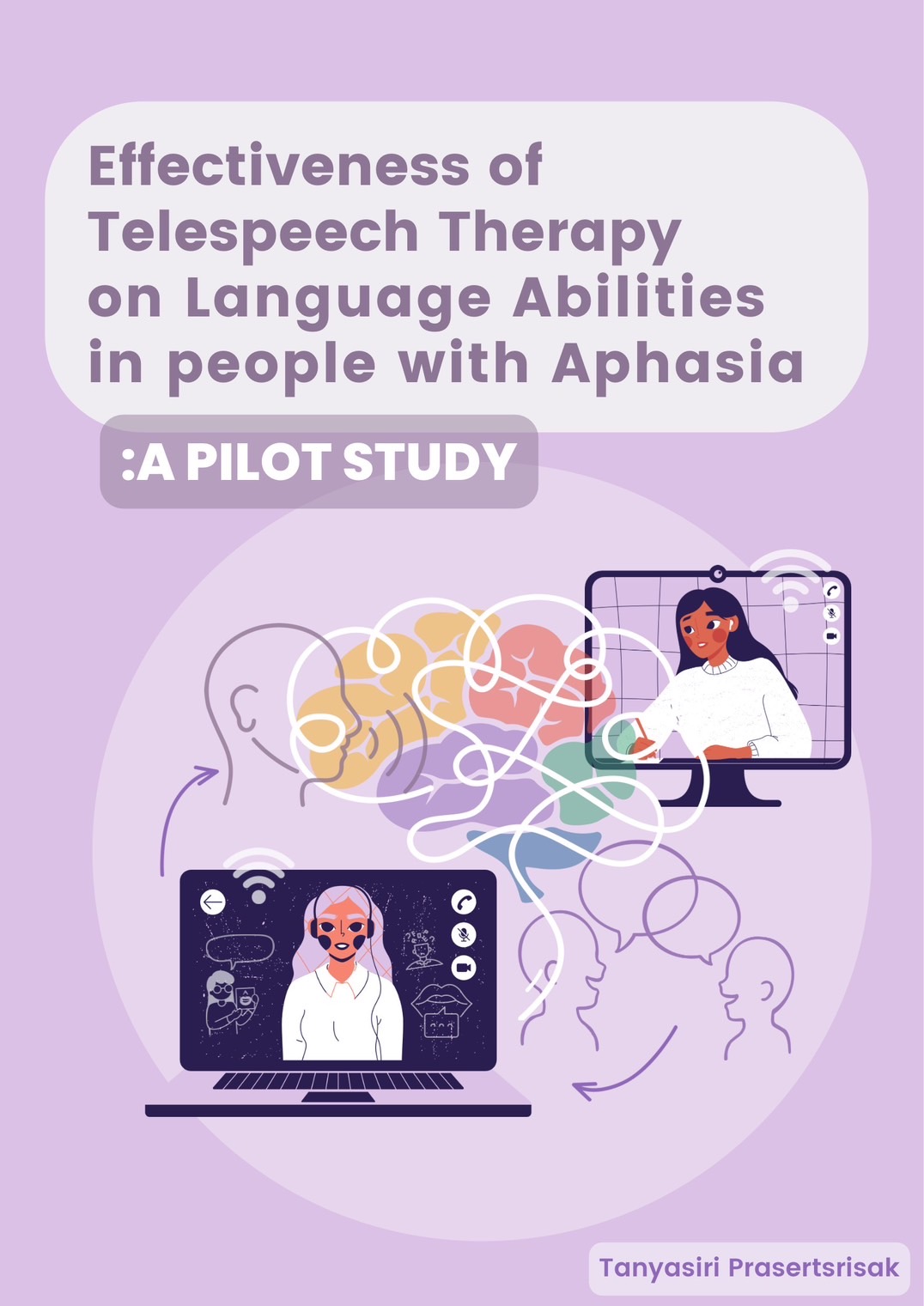Effectiveness of telespeech therapy on language abilities in people with aphasia: A pilot study
Main Article Content
Abstract
Background: Aphasia is a condition that happens when certain areas of the brain responsible for language are damaged, causing difficulties in communicating. Treatment involving speech and language interventions is essential for rehabilitating communication abilities. However, due to accessibility and distancing challenges, access to these medical services has been restricted, especially during COVID-19. Telepractice was introduced as an alternative approach to speech and language therapy. However, there currently needs to be more research on its application, specifically within the aphasia population in Thailand.
Objective: This study aimed to investigate the effectiveness of telepractice in aphasia intervention to enhance the general practice standard and to explore satisfaction with using telepractice in speech therapy among aphasia patients and their caregivers.
Materials and methods: Sixteen participants were recruited for this study, comprising eight aphasia patients and eight caregivers. A standardized aphasia test, the Thai Adaptation of the Western Aphasia Battery (TWAB), was used for pre- and post-assessments. Additionally, satisfaction surveys were employed to gauge significant satisfaction levels among participants. A one-month telepractice intervention (12 sessions in total) was conducted between the pre- and post-assessments to determine the effectiveness of telepractice based on its impact on TWAB test scores.
Results: Overall, this study revealed a significant improvement in the Aphasia Quotient (AQ) as measured by the TWAB test (p=0.011). However, only the repetition and naming sub-tests showed significant improvement between pre- and post-assessment (p=0.019 and p=0.011). The satisfaction levels were reported as high to very high.
Conclusion: This study demonstrated the effectiveness of telepractice in aphasia intervention, particularly in improving naming and repetition skills and eliciting a high to very high level of satisfaction among patients and their caregivers.
Article Details

This work is licensed under a Creative Commons Attribution-NonCommercial-NoDerivatives 4.0 International License.
Personal views expressed by the contributors in their articles are not necessarily those of the Journal of Associated Medical Sciences, Faculty of Associated Medical Sciences, Chiang Mai University.
References
Berthier ML. Poststroke aphasia. Drugs Aging. 2005; 22(2): 163-82. doi.org/10.2165/00002512-200522020-00006
Parr S, Byng S, Gilpin S. Talking about aphasia: Living with loss of language afterstroke. McGraw-Hill Education (UK); 1997.
American Speech-Language-Hearing Association. Aphasia. 2016[cited 2024 Jul 3]. Available from: https://www.asha.org/Practice-Portal/Clinical-Topics/Aphasia/.
Knepley KD, Mao JZ, Wieczorek P, Okoye FO, Jain AP, Harel NY. Impact of telerehabilitation for strokerelated deficits. Telemed e-Health. 2021; 27(3): 239- 46. doi.org/10.1089/tmj.2020.0036
Fong R, Tsai CF, Yiu OY. The implementation of telepractice in speech language pathology in Hong Kong during the COVID-19 pandemic. Telemed e-Health. 2021; 27(1): 30-8. doi.org/10.1089/tmj.2020. 0155
Øra HP, Kirmess M, Brady MC, Winsnes IE, Hansen SM, Becker F. Telerehabilitation for aphasia–protocol of a pragmatic, exploratory, pilot randomized controlled trial. Trials. 2018; 19(1): 1-10. doi.org/10.1186/s13063-018-2702-7
Suphawatjariyakul R, Lorwatanapongsa P, Euasirirattanapaisan A. Handbook for helping people with aphasia. Saraburi: Thaisiri Printing; 2012.
Teerapong W. The comparison of language abilities of Thai aphasic patients and Thai normal subjects by using Thai adaptation of Western Aphasia Battery[Thesis]. Nakhon Pathom: Mahidol University; 2000.
Joshi A, Kale S, Chandel S, Pal DK. Likert scale: Explored and explained. Br J Appl Sci Technol. 2015; 7(4): 396- 403. doi.org/10.9734/BJAST/2015/14975
Fitz-Gibbon CT, Morris LL. How to design a program evaluation. Sage; 1987.
Vanichbuncha K. Statistics for research. 6th ed. Bangkok: Chulalongkorn Business School; 2013.
Choi YH, Park HK, Paik NJ. A telerehabilitation approach for chronic aphasia following stroke. Telemed e-Health. 2016; 22(5): 434-40. doi.org/10.1089/tmj.2015.0100
Jacobs M, Briley PM, Fang X, Ellis C. Telepractice treatment for aphasia: Association between clinical outcomes and client satisfaction. Telemed Rep. 2021; 2(1): 118-24. doi.org/10.1089/tmr.2020.0025
Nguyen M, Waller M, Pandya A, Portnoy J. A review of patient and provider satisfaction with telemedicine. Curr Allergy Asthma Rep. 2020; 20(11): 1-7. doi.org/10.1007/s11882-020-00969-4
Palasik S, Irani F. Evaluating telepractice: Measuring success, cost-benefit, & outcomes. In: Telepractice in Speech-Language Pathology. 2013:187.
Weidner K, Lowman J. Telepractice for adult speechlanguage pathology services: A systematic review. Perspect ASHA Spec Interest Groups. 2020; 5(1): 326- 38. doi.org/10.1044/2019_PERSP-19-00146
Aueworakhunanan T, Dejket P, Phakkachok S, Punkla W. Exploring the feasibility of implementing telepractice innovation for speech-language pathologists in Thailand. Ramathibodi Med J. 2024; 47(1): 32-46. doi.org/10.33165/rmj.2024.47.1.266036


